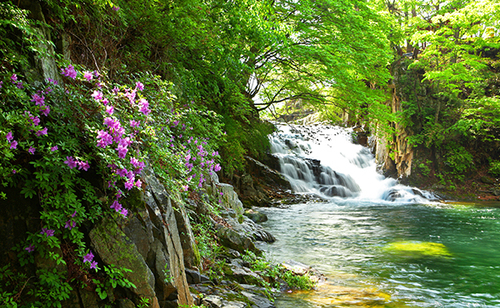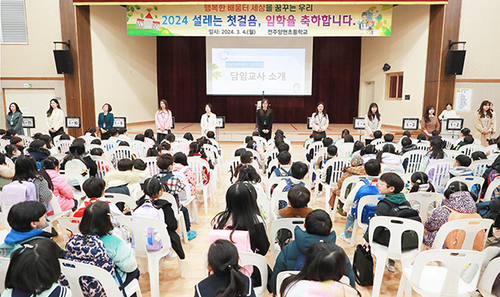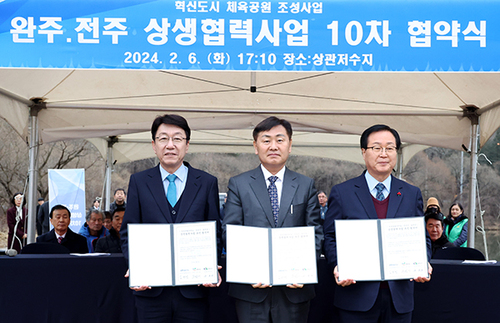| ▲ 유네스코 생물권 보전지역 내 국가습지보호지역이자 국가지질공원인 전북 고창 운곡습지에서 멸종위기 야생동물이 잇따라 포착돼 자연생태계가 잘 보존돼 서식지가 안정화 됐다는 것이 입증됐다. ('담비'가 먹이를 물고 급히 자리를 뜨는 모습이 생생하게 전북지방환경청이 운곡습지에 설치한 센서 카메라에 촬영됐다) / 사진제공 = 고창군청 © 김현종 기자 |
|
유네스코 생물권 보전지역 내 국가습지보호지역이자 국가지질공원인 전북 고창 운곡습지에서 멸종위기 야생동물이 잇따라 포착돼 자연생태계가 잘 보존돼 서식지가 안정화 됐다는 것이 입증됐다.
전북 고창군은 "최근 전북지방환경청이 관리하는 운곡습지에 설치한 센서 카메라에 멸종위기 야생동물인 담비ㆍ수달ㆍ삵 등이 잇따라 포착됐다"고 23일 밝혔다.
영상에 포착된 것은 이번이 처음이다
공개된 영상에는 멸종위기 종(種) 2급으로 호랑이가 자취를 감춘 남한 지역에서 최상위 포식자로 알려진 담비가 먹이를 물고 급히 자리를 뜨는 모습이 생생히 담겼다.
특히 담비의 출현은 운곡습지 생물다양성 측면과 생태계 안정을 확인할 수 있어 큰 의미를 담고 있다.
또, 수달(멸종위기 야생생물 1급ㆍ천연기념물 330호)과 삵(멸종위기 야생생물 2급)ㆍ멧토끼 등의 다양한 포유류들이 이동하는 모습도 카메라에 잡혔다.
고창군은 관련 영상을 전북지방환경청과 협의해 운곡습지 생물 다양성을 홍보하고 생태적 가치 인식을 높이기 위한 영상으로 제작해 배포할 계획이다.
고창읍 운곡리는 습지를 개간해 사용했던 계단식 논이 1984년 아산댐 건설로 운곡리와 용계리 9개 마을 158세대가 물에 잠기면서 저수지가 됐다.
이후 30여년 동안 시간이 멈춰버린 듯 사람의 발길이 끊기면서 자연적으로 생태 복원 과정이 이뤄져 원시 밀림과 같은 비경의 습지로 복원됐다.
운곡습지(1.797㎢ = 약 55만평)에는 환경부 멸종위기 1급 수달ㆍ황새ㆍ2급 삵ㆍ담비ㆍ구렁이ㆍ새호라기ㆍ팔색조ㆍ천연기념물 붉은배사메ㆍ황조롱이 등 360여종의 곤충과 동물ㆍ식물 500여종이 서식해 희귀종의 생태적 보존가치가 높은 곳이다.
국내에서 이 정도 규모의 생물 종이 한 지역에서 서식하는 것은 매우 희귀한 일이다.
고창군청 이성수 생태환경과장은 "운곡습지는 생물종 다양성 유지 기능뿐 아니라 탄소 흡수원으로 탄소 중립에도 기여하는 중요한 자원이다"며 "저수지와 숲이 인접해 물과 먹이가 풍부하고 야생동물이 활동하기 좋은 환경을 갖추고 있는 만큼, 앞으로도 야생동식물의 서식지 보전을 위해 집중 모니터링 및 체계적인 관리기반 구축에 최선의 노력을 다하겠다"고 말했다.
☞ 아래는 위 기사를 구글 번역이 번역한 영문의 '전문'이다.
【Below is the 'full text' of an English article translated from the above article with Google Translate.】
Gochang Ungok Wetland 'Endangered Wildlife' Captured
Marten, otter… Habitat stabilization by preserving natural ecosystems
Reporter Kim Hyun-jong
Endangered wild animals were caught one after another at Ungok Wetland, Gochang, Jeollabuk-do, a national wetland protected area and national geological park within the UNESCO Biosphere Reserve, proving that the natural ecosystem has been well preserved and the habitat has been stabilized.
Gochang-gun, Jeollabuk-do announced on the 23rd that "endangered wild animals such as marten, otter, and pike were caught one after another by a sensor camera recently installed in Ungok Wetland managed by the Jeonbuk Regional Environment Agency."
This is the first time it has been captured on video.
In the released video, a marten, known as the top predator, in the South Korean region, where a tiger, a class 2 endangered species, disappeared, vividly took a bite and left quickly.
In particular, the appearance of marten has great significance in that it can confirm the biodiversity aspect and ecosystem stability of Ungok Wetland.
In addition, various mammals such as otters (endangered wildlife level 1, Natural Monument No. 330), pigs (endangered wildlife level 2), and hare were also caught on camera moving.
Gochang-gun plans to produce and distribute a video to promote the biodiversity of Ungok Wetland and raise awareness of ecological value in consultation with the Jeonbuk Provincial Environment Agency.
In Ungok-ri, Gochang-eup, the terraced rice fields that were used after reclaiming wetlands became a reservoir when the Asan Dam was built in 1984 and 158 households in 9 villages in Ungok-ri and Yonggye-ri were submerged.
After 30 years, as time stopped, people stopped walking, and the ecological restoration process took place naturally, and it was restored to an unexplored wetland like a primitive jungle.
In Ungok Wetland (1.797㎢ = about 550,000 pyeong), the Ministry of Environment has 500 species of insects, animals, and plants, including 360 species of endangered otters, storks, class 2 pigs, marten, snakes, falcons, natural monuments red basil and kestrels. It is a place with high ecological conservation value for rare species as it is home to female species.
It is very rare for a species of this size to live in one area in Korea.
"Ungok Wetland is an important resource that not only maintains biodiversity, but also contributes to carbon neutrality as a carbon sink," said Seongsu Lee, head of the Ecology and Environment Division at Gochang-gun Office. As the environment is in place, we will continue to do our best to establish a foundation for intensive monitoring and systematic management to preserve the habitats of wild animals and plants."





















 많이 본 뉴스
많이 본 뉴스











